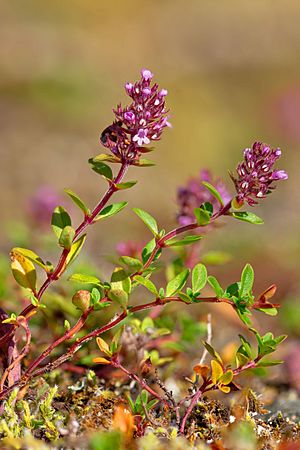Thymus pulegioides facts for kids
Quick facts for kids Thymus pulegioides |
|
|---|---|
 |
|
| Scientific classification | |
| Genus: |
Thymus (plant)
|
| Species: |
pulegioides
|
| Synonyms | |
|
Thymus ovatus Mill. |
|
Thymus pulegioides, often called broad-leaved thyme or lemon thyme, is a type of flowering plant. It belongs to the mint family, called Lamiaceae. This plant originally comes from Europe.
It's a small, spreading plant that grows between 5 and 25 centimeters (about 2 to 10 inches) tall. It can spread out about 25 centimeters (10 inches) wide. Its leaves have a strong, pleasant smell, and it produces pretty lilac-pink flowers in early summer. The name pulegioides means it looks a bit like another plant in the same family, called Mentha pulegium (pennyroyal).
Contents
What Does Broad-Leaved Thyme Look Like?
Broad-leaved thyme is a small, low-growing plant that stays green all year. It has woody stems and a main root that goes deep into the ground. It's quite similar to wild thyme, but broad-leaved thyme is usually bigger. Its leaves are also wider, and all its stems grow flowers.
The stems are reddish and have a square shape when you look at them closely. They also have tiny hairs along their edges. The leaves grow in pairs opposite each other on short stalks. They are shaped like long ovals, getting narrower at the bottom, and have smooth edges.
Flowers and Fruit
This plant blooms in July and August. Its flowers are usually pink or light purple and grow in round clusters. Each flower has a tube-like outer part (called a calyx) and a hairy, irregular inner part (called a corolla). The top petal of the flower has a small dip in it. The bottom petal is larger than the two side petals and has three flat parts that form a "lip." Each flower has four parts that stick out (stamens) and two parts that are joined together (carpels). After the flowers, the plant produces a dry fruit with four small sections.
Where Does Broad-Leaved Thyme Grow?
Broad-leaved thyme is found naturally in the mild, temperate parts of Europe. It likes to grow in rough areas where the soil is light and not too rich. You can often find it on hills, rocky spots, gravel, sandy areas, empty lots, and along roadsides.
Growing Broad-Leaved Thyme in Your Garden
This type of thyme is great for gardens! It grows well in sunny spots with soil that drains water easily. It prefers soil that is either alkaline (like chalky soil) or neutral.
It's often used as a groundcover, meaning it spreads out and covers the ground. You can also use it in cooking, just like regular thyme. Gardeners have chosen many special types of broad-leaved thyme over the years. Two popular ones are 'Aureus', which has gold-colored leaves that smell like lemon, and 'Bertram Anderson'. Both of these have won awards from the Royal Horticultural Society for being excellent garden plants.
See also
In Spanish: Thymus pulegioides para niños

